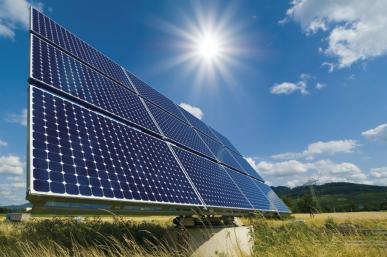Imagine a world where homes not only run on clean electricity but also generate, store, and sell it. A world where power companies get paid for conserving energy, not just producing it. Where, when supplies are tight, the power grid gives customers the option of being paid to reduce and even shift their energy use to a different time of day, allowing us to use more renewable energy.
The U.S. is poised to spend around $2 trillion over the next two decades replacing our outdated electric infrastructure. We must make sure those investments are not spent on replacing old, dirty power plants with more of the same. If we’re truly going to unleash the clean energy future, we must invest in renewable energy and a smarter grid that can smooth out the demand for power and reduce harmful air pollution.
Now, more than ever, we need to be smarter about the way electricity is made, moved and used, and EDF is working to bring forth a new, dynamic approach to American energy- one that wastes less and generates more clean, on-site, local energy that puts customers in the driver’s seat.
This is a vision of a smarter, cleaner, more reliable energy system, and it’s the vision that drives the EDF Clean Energy Program. Starting in nine states that make up nearly half of the U.S. energy market, this program aims to transform our country’s outmoded electricity system to clear the way for clean energy.
In true EDF fashion, that means choosing our issues strategically and focusing our efforts where they will make the greatest impact. These decisions are governed primarily at the state level by state Public Utility Commissions (PUCs), so EDF is working with state PUCs, state legislators and other partners to advance clean energy solutions in Texas, California, Florida, North Carolina, Ohio, Illinois, Pennsylvania, New Jersey, and New York.
How will we get there?
First, we want to ensure the rules of the road fairly values clean, reliable energy. This means revising a century-old utility business model, which currently measures success by the amount of megawatts sold, to one that rewards utilities for generating and selling energy more wisely, sustainably, and efficiently. The cleanest and cheapest megawatt is the one utilities don’t have to generate, and energy efficiency measures and proven tools like demand response are making smarter, more efficient energy use a practical reality. We’re working to make the “negawatt” profitable for utilities.
Many of the needed changes will require significant upgrades to our aging power grid and a legacy of outdated policies that are stifling energy innovation. Our work with energy research pioneer Pecan Street Inc. in Austin, TX is already yielding remarkable insight for utilities about how a smarter, cleaner grid (and smarter, more engaged customers) can reduce the need for expensive, polluting power plants. And our work with public utility commissions and legislatures in these key states will help eliminate bureaucratic rules that prevent entrepreneurs from entering this market.
Finally, we want to help open the floodgates for investment in residential and commercial clean energy upgrades. Today, homeowners that want to install rooftop solar and facility managers that want to reduce their buildings’ carbon footprint face a similar lack of financing options. Our team is working with the investment community to establish new financing tools, like on-bill repayment (OBR), for projects large and small. EDF’s Investor Confidence Project is making huge strides in how energy efficiency upgrades for commercial buildings are financed, by introducing a system of standardization in how projects are funded, managed, and tracked. These standardized protocols are able to serve as a “recipe book” for ‘investor ready’ energy efficiency projects and the result is a commercial building sector with lower operating costs, higher market value, and a significantly lower carbon footprint.
We think America’s greatest contribution to the health of the planet today can be to pioneer an open, vibrant market for clean energy that sparks private capital and technological innovation, creates jobs, and delivers affordable, efficient, clean energy. But we need new rules, new ideas, and new approaches to overcome a century of the carbon-based “business as usual.”
Tracking our progress, looking ahead
Across the country, elected officials and business leaders are achieving some important victories, and our team has been working with them to provide technical and policy assistance.
Just last month, New Jersey’s Office of Clean Energy released a proposal to allocate $2.5 million for incentives that would encourage more energy storage use. In Minnesota, the state PUC established the first statewide program to fairly value investments in rooftop solar electricity generation. In Illinois, Commonwealth Edison Company (ComEd) proposed an accelerated timetable for completing its deployment of four million smart meters – a key component of a modernized grid. In February, California state senator Kevin de León introduced a bill to establish the first “Green Bank” in California, a bold proposal that would unleash low-cost financing opportunities for clean energy projects throughout the Golden State. And in New York, where Superstorm Sandy knocked out power for millions less than two years ago, the Public Service Commission ordered the state’s largest utility in February to begin implementing one of the most comprehensive storm resiliency plans in the nation.
A lot is happening in the EDF Clean Energy Program’s priority states thanks to public-private partnerships between visionary elected officials, experts in the field, and innovative entrepreneurs, among others. Even still, there is a lot of opposition to progress from the fossil-fuel industry and global warming deniers. But thanks to EDF supporters like you, our team is on the ground where the rubber hits the road (or where good ideas hit roadblocks). Our action plan for 2014 includes increased activity in each of these key states, and we will update you throughout the year on our blog, the Energy Exchange, as our efforts continue to produce results.
This commentary originally appeared on our EDF Voices blog.










